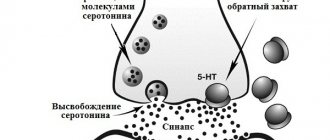Human nerves are built just like electrical wires. Just like any cable, the nerve has its own insulation - it is called the myelin sheath. Only its functions are slightly different. While conventional insulation is primarily needed to ensure that no one gets electrocuted, myelin plays an important role in the normal functioning of the nerve.
Our expert in this field:
Lashch Natalia Yurievna
Neurologist of the highest category, candidate of medical sciences, associate professor. Laureate of the Moscow City Prize in the field of medicine.
Call the doctor Reviews about the doctor
Multiple sclerosis (MS) is a disease in which the myelin sheath is destroyed. This leads to neurological disorders that worsen over time.
What are the possible consequences of multiple sclerosis in men and women?
The disease has a chronic course. The prognosis and possible consequences depend on the gender, age of the patient, the course of MS, and what the symptoms were at the onset of the disease. On average, sick people live 5-10 years less than healthy people. Almost half live to age 60 or older.
Over time, serious complications may arise:
- convulsions, fits, as in epilepsy;
- muscle stiffness;
- paralysis, usually in the leg muscles;
- severe memory impairment;
- mood swings;
- urinary and stool incontinence;
- depression.
Multiple sclerosis is a serious disease and requires individually tailored treatment. The patient should be regularly monitored by a neurologist.
Treatment
Due to the complexity of the disease, treatment directly depends on determining the extent of the disease. If we say that multiple sclerosis, its treatment is the ingestion of medications or the use of certain techniques or a combination of the above, this will be a deeply incomplete answer. Modern medicine today uses immunosuppressants - cytostatics, steroids; neuroprotectors, nootropic drugs, translingual stimulation, fasting and yoga. A patient with MS needs to be regularly examined by an electrophysiologist, immunologist, or urologist. neurologist, neuro-ophthalmologist, neuropsychologist. Treatment directly depends on the stage of the disease. If it is possible to determine the exact stage, this simplifies the treatment process and allows you to avoid spending extra money on expensive drugs.
Stages
The initial form of multiple sclerosis is characterized by the fact that it does not show itself in any way. An MRI performed by chance, performed or planned reveals very minor brain damage, which shows that a small part of the nerve fibers is affected, and healthy nerve fibers have taken over the function of the lost ones. At this stage, you only need to visit a neurologist. Multiple sclerosis, the stages of which have gone beyond the framework of imperceptible symptoms, requires collecting an anamnesis and determining the path of treatment. Identifying the area of the nervous system from which to begin diagnosis often determines the success of treatment. When a disease is identified and it shows obvious characteristic signs, this is considered to be the form of the disease. At this stage, a treatment method is chosen, and if there is progress in treatment, then they continue to use this method; if the disease progresses, they change the method and medications until there is a noticeable improvement. The final stage is characterized by increased neuropsychological disorders with a deep decrease in intelligence; changes are expressed in the form of asthenic syndrome, hysterical reactions, depression or, less often, euphoria, lack of control over one’s emotions, and emotional instability. The combination of these stages, depending on the individual characteristics of the course of the disease, includes four stages of multiple sclerosis: remitting - when improvement occurs between exacerbations; primary progressive – constant deterioration from the first signs of the disease; secondary progressive – continuous progression of the disease; remitting-progressive, when exacerbations alternate with the frequency of manifestations of the disease in the period between attacks.
Treatment methods
When the first signs of multiple sclerosis appear, it is already necessary to begin treatment by contacting specialists at the clinic. Currently, such directions in the treatment of this disease are known as: – PMTRS - preventive drug therapy.
Today, science knows ways to slow down the course of MS and ways to reduce the number of attacks. This is achieved with immunomodulators, which also reduce the activity of antibodies - these are interferon beta and glatiramer acetate. Interferon beta prevents the growth of cells of the immune system; glatiramer acetate is like a myelin protein for the body, which takes over the work of the immune system. Treatment is not limited to medications alone. Procedures and activities that restore motor functions are also necessary.
Symptomatic treatment
Symptoms of the disease appear and appear in altered form regularly. Practice shows that no two people are alike and have the same set of manifestations of the disease. Destroying parts of the brain and spinal cord, MS manifests itself individually in each patient. Early multiple sclerosis, manifesting itself as muscle spasticity, is treated with drugs containing baclofen, tolperisone, and tizanidine. Weakening of urinary function is normalized by intravenous administration of levocarnitine. For difficult coordination of movements and tremors, glycine is used. To restore mental abilities, they give the patient psychostimulants and nootropic drugs.
Treatment of exacerbations
MS is characterized by episodic exacerbations. After completing a course of localizing the exacerbation, the attending physician selects a medicine that changes the course of the disease. It is believed that the new drug can delay the exacerbation of multiple sclerosis.
Translingual neurostimulation
Multiple sclerosis is a serious disease of the nervous system. The reasons for the occurrence have not yet been clarified. The course of the disease is influenced by two processes: autoimmune inflammation and neurodegeneration.
Modern medications can only slow down the course of the disease.
The most effective drug is Alemtuzumab, which eliminates disease progression in 95 percent of cases for 13 years. https://www.ncbi.nlm.nih.gov/pubmed/24849515 Treatment with this drug is quite expensive.
But not everything is so hopeless. There are more affordable treatments. These are Dr. Coimbra's protocol and Dr. Klenner's protocol. Anyone can find out a detailed description of these protocols on the Internet. Moreover, it is possible to combine them. Both of these methods make it possible to stabilize the patient’s condition, ensuring that the disease does not progress.
The next step after stabilizing the condition is to eliminate the existing neurological deficit and maintain the existing functions of the nervous system. At this stage it is necessary to use Neuroport.
The rehabilitation potential of NEUROPORT is not limited only to enhancing remyelination and creating new connections, but also to optimizing the functions of excitation and inhibition, as well as strengthening synaptic transmission. In addition, the developer of the translingual sitimulation method, Yu. P. Danilov, repeatedly emphasizes that when using the device, a network of glial cells is used, which also conduct impulses in the same way as neurons. So the effect of the device is multifaceted and its rehabilitation potential is not fully realized immediately, but over several months of constant use.
Thus, the use of the Coimbra and Klenner protocols and daily use of Neuroport will allow patients with multiple sclerosis to overcome this disease.
Each treatment method is selected and combined individually, depending on the stage of the disease, the course of the disease and the experience of the attending physician.
Treatment of multiple sclerosis in Moscow at the international clinic Medica24
During an exacerbation of the disease, corticosteroids are used - preparations of the adrenal cortex. They suppress immune reactions and inflammation. If the symptoms are very severe and medications do not help cope with them, they resort to plasmapheresis, a blood purification procedure.
To prevent attacks and slow down the progression of the disease, special drugs are used that change the course of multiple sclerosis - DMTs. They began to be widely used at the end of the 20th century. Treatment of PED is a rather complex process. The doctor must have the appropriate competence, be able to select the right combination of drugs, and guide the patient on them. Today in Moscow there are multiple sclerosis treatment centers that deal with this area of therapy.
Treatment of multiple sclerosis (MSD) should begin as early as possible, after the diagnosis is established - in this case, the best effect can be achieved. But even if the patient’s condition has deteriorated significantly, this is not a reason to give up. Contact a specialist.
At the Neurology Center of the International Clinic Medica24 you can get a consultation with an experienced neurologist. Call +7 to make an appointment with a doctor on a weekday or weekend.
Depending on which nerve fibers are affected, the manifestations of multiple sclerosis may vary. In addition, the course of the disease varies. As a rule, the first symptoms begin to bother you at the age of 20-40. Women get sick more often than men.
Symptomatic treatment
The goal of symptomatic therapy is to eliminate or alleviate existing neurological symptoms. Symptomatic therapy has no effect on the course of MS itself, but can improve the patient’s quality of life. For this purpose, drugs of various groups are used. Often, the same remedy simultaneously eliminates several manifestations of multiple sclerosis.
Synthetic analogues of GABA
Gamma-aminobutyric acid is one of the so-called. inhibitory mediators in the central nervous system. Damage to brain structures in multiple sclerosis is accompanied by the elimination of inhibitory impulses with the development of muscle spasms and spastic pain. Such symptoms are eliminated with the help of Baclofen. This synthetic analogue of GABA restores inhibitory impulses and inhibits spasm. Baclofen relaxes not only skeletal but also smooth muscles. Therefore, it can be used for spastic constipation and difficulty emptying the bladder.
Benzodiazepines
Benzodiazepine derivatives (Diazepam, Clonazepam) are similar in properties to GABA. They enhance the effect of Baclofen and also have tranquilizer properties. Therefore, they are used to eliminate anxiety and fear in patients with multiple sclerosis. In addition, benzodiazepines have analgesic properties - they can eliminate pain.
Anticholinergics
These drugs normalize muscle tone by influencing central and peripheral cholinergic receptors. "Mydocalm", "Hyoscyamine", "Oxybutynin" are used to relieve spasms of skeletal muscles, smooth muscles of the intestines and bladder.
Antiepileptic drugs
They can also be useful for multiple sclerosis. “Carbamazepine”, “Phenytoin” prevent the development of seizures, normalize sensitivity, and are effective for neuritis accompanied by pain, impaired swallowing and speech.
Tricyclic antidepressants
Eliminates feelings of depression and fatigue, improves mood and performance. These drugs also normalize muscle tone and eliminate pain.
Vitamins
The importance of these biologically active substances in multiple sclerosis is difficult to overestimate. B vitamins normalize sensitivity and movement, ascorbic acid improves immunity, vitamin E strengthens blood vessels, and vitamin D prevents the development of osteoporosis, a frequent companion of multiple sclerosis. All drugs for the symptomatic treatment of multiple sclerosis are used only as prescribed by a doctor and under his supervision.
Pulse therapy
In cases of exacerbation of symptoms of multiple sclerosis or the appearance of new symptoms, pulse therapy is used - intravenous administration of loading doses of a hormonal drug.
The best results are shown by the administration of 6-methylprednisolone. This drug has powerful anti-inflammatory, anti-edematous and immunomodulatory effects.
The hormonal agent is administered intravenously through a dropper. The duration of the course is from 3 to 7 days. Pulse therapy at the international clinic Medica24 is carried out according to protocols that have proven their effectiveness based on the results of clinical randomized studies, taking into account the individual characteristics of the patient.
Indications for pulse therapy are symptoms of damage to the brain stem, cerebellum, and spinal cord. The goal of treatment is to relieve acute symptoms, improve the condition and slow down the development of multiple sclerosis.
The decision to conduct pulse therapy at the Medica24 international clinic is made on the basis of MRI data (with a contrast agent), in the presence of active foci of demyelination, the appearance of new foci or the growth of old ones. MRI data must be confirmed by changes in the clinical picture of the disease.
As a result of pulse therapy for multiple sclerosis at the international clinic Medica24, a significant improvement in the condition is achieved - dizziness, unsteadiness of gait, numbness and weakness of the arms and legs disappear, and vision improves.
The development of the disease slows down, regression of symptoms and even achievement of remission is possible.
On the other hand, the use of loading doses of a corticosteroid may lead to side effects. Some of them are minor - insomnia, slight euphoria or anxiety, nausea, hiccups, headache, increased appetite. Others are more dangerous - cardiac arrhythmia, hyperglycemia, sudden fluctuations in blood pressure, bleeding.
Therefore, a course of pulse therapy for multiple sclerosis is best carried out in a hospital setting, where the patient is under constant medical supervision. This allows you to adjust the treatment course in time and eliminate side effects.
The international clinic Medica24 has extensive experience in treating multiple sclerosis with loading doses of glucocorticoids, achieving maximum results with minimal side effects and timely correction of the patient’s condition.
Take care of yourself, book a consultation now
Message sent!
expect a call, we will contact you shortly
Treatment of exacerbations
During exacerbations, therapy is carried out using potent anti-inflammatory drugs and corticosteroid hormones. The regimens and doses of administration of these drugs are individually determined by the doctor depending on the patient’s condition. Along with corticosteroids, during an exacerbation, drugs that improve the functions of nervous tissue (so-called neuroprotectors), drugs that strengthen the vascular wall, and drugs that improve the rheological properties of the blood are usually prescribed. In the absence of contraindications, physical therapy and physiotherapeutic procedures are indicated.
The most common symptoms of multiple sclerosis in women and men
The severity of manifestations of multiple sclerosis varies. Most people experience the following:
- Unusual sensations in different areas of the body. This may be numbness, unpleasant tingling (“like needles”), burning, itching. Similar signs occur in approximately 50% of patients.
- Bladder disorders. Occurs in approximately 80% of patients. Often has the urge to go to the toilet, including at night, and is bothered by the feeling as if the bladder is not completely emptied.
- Intestinal disorders. Manifests itself in the form of constipation.
- Walking disorder. The disease is often accompanied by weakness and muscle cramps, along with numbness in the legs, dizziness, and problems maintaining balance. This makes it difficult to walk.
- Dizziness.
- Constant fatigue. It is especially disturbing in the afternoon, even if the person had rested all day before. The patient may feel tired even after sleep. This manifests itself in the form of difficulty inhibited thinking, muscle weakness, and drowsiness. This condition occurs in approximately 80% of patients.
- Muscle spasms. Occur in approximately 40% of cases, usually affecting the leg muscles. Feelings range from tension, stiffness to painful spasms.
- Problems with thinking. About 50% of patients are bothered by symptoms such as slow thinking, memory impairment, and decreased concentration.
- Speech disorders. The patient may speak through his nose, slurred, and take long breaks between words.
- Swallowing disorders. Occurs in the later stages of the disease.
- Problems in the intimate sphere. Signs of multiple sclerosis in women may include vaginal dryness, and in men - weakening of erections.
Fortunately, many symptoms of multiple sclerosis have effective treatments and can be kept under control. To do this, you need to constantly be under the supervision of a neurologist and conscientiously follow all prescriptions and recommendations.
If symptoms from this list appear, especially if they continue for a long time, you should immediately contact an experienced neurologist. It may not be multiple sclerosis, but there is always a risk, and if the diagnosis is confirmed, it is better to start treatment immediately.
Multiple sclerosis is not a death sentence (Institute of Medical Communications)
Irina Vadimovna Kazantseva, neurologist, Ph.D. , head of the 1st neurological department of the Federal State Budgetary Institution "Clinical Hospital No. 1" of the Administration of the President of the Russian Federation (Volynskaya), told the Institute of Medical Communications (IMC) about what young patients face, how to lead a full life with a neurological disease and why multiple sclerosis - not a sentence.
The Institute of Medical Communications was founded in Paris in 1992 with the goal of qualitatively improving communication in medical and pharmaceutical activities. The goal of the project was to align the standards and procedures for providing medical care, including medicinal care, to the population of all countries of the world.
The activities of the institute are non-profit and carry educational motives aimed at the implementation of modern methods of treatment, management and control of the medical industry.
The Institute's target audiences are doctors, healthcare organizers, patients, the media, representatives of legislative and executive authorities, pharmaceutical and medical companies.
The Institute brings together the efforts of all stakeholders and organizations in the field of health care to improve the health of the population everywhere.
IMC: What problems do patients most often come to you with?
Irina Vadimovna: About half of all patients are admitted with chronic cerebrovascular insufficiency. 30% are patients with various types of pain: back pain syndromes, facial pain and headaches. Recently, the flow of patients with rare neurodegenerative pathologies has increased: Alzheimer's disease, Pick's disease. We also receive patients with multiple sclerosis for various neurological pathologies.
IMC: Probably each age has its own neurological diseases?
Irina Vadimovna: 20% of our patients are over 80 years old. The older the patient is, the more likely it is that he has accumulated some genetic defects or age-related changes that cause the problem.
Over the past few years, we have become deeply involved in cognitive impairment. Patients aged 30 and 40 come to us with complaints of poor memory. We have evidence and examinations that can show that memory impairment in a given patient significantly exceeds the threshold that exists in this age group.
In a young patient, these problems are most often associated with neurotic disorders. We all live in a state of stress and sometimes the brain is simply unable to absorb information and dismisses it as unnecessary. Our task is to identify the cause of violations. If it is a neurosis, then we give appropriate recommendations: depending on the cause, we prescribe mild nootropic or antioxidant drugs, recommend procedures to help you relax, and conduct classes with a neuropsychologist.
IMC: How does a doctor work with young patients with neuroses?
Irina Vadimovna: The task of a neurologist is to divide patients into two categories: with organic damage to the nervous system and with neurosis. Both categories may have the same symptoms: headaches, dizziness, but the causes are different.
Patients are often perplexed: “I came to you with a headache, and you say that the reason is that I cannot cope with my emotional stress.” We must examine the patient and show that the cause of headaches or heart pain is purely emotional.
IMC: How do you feel about the widespread practice of self-medication today?
Irina Vadimovna: I really don’t like it when patients start sitting on forums and reading annotations for medications. This means that the patient has not found a doctor who would become his assistant, advisor, or friend. A specialist must predict, warn, and help cope with symptoms. As a rule, help on forums is sought by those who have not been explained what and how to do, or by people with sad experiences with medicine. Our patient should not read discussions on forums. He must find his doctor or a medical institution where they will do everything possible to preserve his health.
IMC: What principles do you follow when working with patients?
Irina Vadimovna: The very atmosphere of our hospital has a psychotherapeutic effect and helps the patient relax. Our medical institution is an island of silence in stormy Moscow. Centuries-old trees grow on the territory, birds sing, squirrels jump. Patients do not have the feeling that they are in a hospital, but rather in a sanatorium-resort institution. Even our employees often wear colored gowns instead of white ones, so as not to create the impression of a standard hospital, which is associated with unpleasant odors, pain, and tears.
Our department professes the principle: if after communicating with the doctor the patient does not feel better, then he did not see the doctor. In relation to multiple sclerosis, we have a rule: we report every patient to whom we have given this diagnosis, while he is still being observed with us, to the Multiple Sclerosis Center in Moscow. This is the coordination center that is responsible for providing our citizens with free expensive medicines. At the moment when the patient needs to switch to anti-relapse therapy, they will already know about him and, thus, he will immediately be able to receive all the necessary drugs.
IMC: Do patients with a neurological pathology such as multiple sclerosis require special treatment?
Irina Vadimovna: This is written in all the manuscripts devoted to multiple sclerosis, we see this too: no two patients with multiple sclerosis who would have common problems. Patients are all different. You won’t see any common symptoms: someone came with transient blindness in one eye, someone with a distorted face because they have neuropathy of the facial nerve, for someone multiple sclerosis debuted through facial pain - trigeminal neuralgia.
Today, all necessary services have been created for patients with multiple sclerosis. Most importantly, he must understand the need for treatment and be regularly monitored by a doctor.
IMC: How many years can the period from the manifestation of the disease to the patient’s disability last?
Irina Vadimovna: Multiple sclerosis can occur with virtually no exacerbations, or it can recur regularly.
I have a patient that I have been seeing for 18 years. For many years, even her relatives did not know that she had such a serious illness. For 18 years, while using anti-relapse therapy, she had no exacerbations. She drives, works, and has no neurological defect. And there is a patient who was diagnosed 2 years ago, and she comes to us 3-4 times a year with exacerbations.
Much depends on how a person behaves and how deeply he listens to our recommendations. We had one patient whom we diagnosed with multiple sclerosis. She passed the selection and was going to go to a reality show in Mexico, where there was crazy heat, sun, and physical activity, which was strictly forbidden to her. But she decided that this was more important for her, and she went.
In medical practice, favorable and unfavorable prognostic signs have been identified. It is believed that the earlier a person gets sick, the milder and more prosperous the course of multiple sclerosis will be. Gender also has an impact: in women, the disease is more common and has a milder course. Even by what first symptom develops in a person, one can judge the development of the disease. And yet, with multiple sclerosis, everything is very individual. This disease is like a detective story: despite the fact that it has been studied a lot, a lot has been described, even more questions arise.
IMC: Is therapy also prescribed to patients individually?
Irina Vadimovna: There are two problems in the treatment of multiple sclerosis: to relieve exacerbation and clinical manifestations caused by the appearance of a new plaque, and to prevent relapse. As a rule, the symptoms with which the patient was admitted go away by the end of treatment in the hospital. Next, you need to understand when to start anti-relapse treatment and teach the patient how to carry it out.
The decision to prescribe a particular drug is made after the appearance of a second exacerbation. The difficulty is that after the symptoms are relieved, we send the person home, and we do not know when the next attack of multiple sclerosis will occur. If the patient was unable to relieve all symptoms after the first lesion, this may be a reason to prescribe anti-relapse therapy after the first episode.
Anti-relapse drugs are highly effective, and the state provides these expensive medications to patients, the main thing is adherence to treatment. However, many of them are difficult to tolerate. There are drugs from the group of interferons that a person injects every night or at a less frequent frequency, and each time after the drug is administered, the patient experiences symptoms similar to a flu attack: at night his temperature rises, he experiences muscle pain, and it is impossible to skip the injection.
If a particular drug is fundamentally unsuitable for a person, we have the opportunity to replace it with a drug from another group. All these problems are individual, but solvable. Much depends on how the person adheres to the treatment regimen. Some give up, and after some time they come to us with an aggravation.
IMC: Do doctors encounter difficulties when working with patients with multiple sclerosis?
Irina Vadimovna: Educating a patient and telling them how to live with an illness is a difficult task. But patients with multiple sclerosis are fighters, they rarely give up and always come to the doctor with hope.
We try not to set strict restrictions. If a patient has the opportunity to get a little pleasure from life, we do not prohibit it. For example, a person asks if he can go traveling. We try to find options so as not to completely limit a person and not change the quality of life for the worse.
Our doctors spend part of their working time on the phone with patients. If a patient has questions, he or his relatives can always call us and discuss any problem that has arisen.
http://www. instmedcom. org/news/esli-posle-obshcheniya-s-vrachom-pacientu-ne-stalo-legche-znachit-byl-ne-u-vracha
Causes of multiple sclerosis in men and women: factors that increase risks
There is no clear reason why some people develop the disease and others do not. However, there are some known risk factors that increase the likelihood of developing multiple sclerosis:
- Female. For unknown reasons, women get sick twice as often as men.
- Age. The first signs of the disease usually appear at the age of 15-60 years (most often at 20-40 years).
- Some infections. For example, it is known that the risks are increased by infectious mononucleosis, a disease caused by the Epstein-Barr virus.
- Having sick relatives. You are at greater risk if one of your parents or siblings has already been diagnosed with multiple sclerosis.
- Ethnicity. The disease is most common among the indigenous people of Northern Europe. Asians, Africans and American Indians have the lowest risks.
- Some diseases. The risk is increased by certain thyroid diseases, inflammatory pathologies in the intestines, and type I diabetes.
- Smoking. Smokers develop MS more often than non-smokers.
If you or your relative experience the first suspicious symptoms, immediately contact an experienced neurologist.
Multiple sclerosis: causes of disease symptoms
Sometimes there are three groups of manifestations of multiple sclerosis, each of which is caused by certain reasons:
- Initial disorders are associated with damage by the immune system to the sheaths of nerve fibers. As a result, the passage of nerve impulses is disrupted, and corresponding neurological disorders occur.
- In turn, this leads to disruption of the functioning of internal organs and the development of secondary disorders. For example, if the bladder stops functioning normally, the risk of genitourinary tract infections increases.
- All this cannot but affect the quality of life, performance, and social adaptation of a person. The resulting disorders lead to psychological problems.
Treatment should target all of these causative factors in multiple sclerosis. It is necessary to keep the main symptoms of the disease under control, combat complications from internal organs and carry out rehabilitation treatment, and strive to ensure that the sick person lives as full a life as possible.
Since the causes of the disease in multiple sclerosis are not fully known, there are no effective methods of prevention. It is extremely important to notice the first symptoms in time and immediately consult a doctor. If you need a consultation with a neurologist, you can make an appointment with a specialist at the international clinic of modern neurology Medica24 around the clock. Just call.
Get a correspondence consultation with a neurologist
Message sent!
expect a call, we will contact you shortly
An appointment with a doctor begins with a conversation. The neurologist needs to figure out what symptoms bother the patient, when and how they arise, what provokes them, whether there are exacerbations, and how the condition changes over time. A neurological examination is then performed.
It is important that the neurologist carefully evaluates the patient’s condition and excludes all other possible diseases.
In a relapsing-remitting course, when the disease periodically goes through stages of exacerbation and improvement, the diagnosis is relatively easy to establish based on the clinical picture of multiple sclerosis and MRI data. If the patient is concerned about unusual symptoms or the disease is constantly progressing, other tests may be needed.
Drugs
Glucocorticoids
These are synthetic analogues of adrenal hormones - Prednisolone, Methylprednisolone, Dexamethasone. These drugs for multiple sclerosis block certain biologically active substances of the cytokine class and reduce the production of T-lymphocytes. Thus, glucocorticoids inhibit inflammatory and autoimmune processes. In addition, these drugs reduce the permeability of vascular walls and the BBB. Glucocorticoids for multiple sclerosis are used in pulse therapy mode - in large doses over short periods of time.
ACTH
Adrenocorticotropic hormone is secreted by the anterior pituitary gland and stimulates the production of its own glucocorticoids by the adrenal cortex. Thus, the effect of ACTH and its synthetic analogues (Synacten, Tetracosactide) is similar to the drug of the previous group, but has less risk of side effects (ulceration, hypercortisolism). Although in this case, disturbances in water-salt metabolism and increased blood pressure are possible.
Synthetic beta interferons
(“Avonex”, “Rebif”, “Betaferon”) have an immunomodulatory effect, inhibit autoimmune processes, reduce the activity of T-lymphocytes, and prevent the penetration of cytokines through the BBB. In addition, beta interferons are effective in the initial stages of viral infections, one of the causes of multiple sclerosis.
Copaxone
This drug has immunomodulatory properties and is specially designed for the treatment of multiple sclerosis. It is a sequence of amino acids glutamine, lysine, alanine, tyrosine. Its chemical structure is similar to myelin.
Angioprotectors and antiplatelet agents
These drugs (“Curantil”, “Pentoxifylline”) prevent red blood cells from sticking together, improve blood flow and strengthen the vascular wall.
Proteolytic enzyme inhibitors
When administered intravenously, Contrikal and Gordox inhibit enzymes of the protease class, which destroy protein structures and participate in inflammatory processes. Plasmapheresis, a method of hardware extracorporeal (outside the body) blood purification, gives good results. During plasmapheresis, antigenic complexes, biologically active substances that trigger autoimmune processes, are removed along with plasma. Not so long ago, the drug Anti-LINGO-1 was developed in the USA, which accelerates remyelination. Now this drug is in the clinical trial phase, but perhaps it will still say a new word in the treatment of multiple sclerosis.
What studies and tests help diagnose multiple sclerosis?
For diagnostic purposes, the doctor may prescribe the following tests:
- Blood tests. Helps rule out other diseases. There are no specific substances that would indicate multiple sclerosis; scientists are currently busy developing such diagnostic tests.
- Spinal tap. Between two vertebrae in the lower back, a needle is inserted into the space around the spinal cord and a small amount of cerebrospinal fluid is obtained for analysis. It detects antibodies associated with MS, which also helps rule out other diseases.
- MRI. The test reveals damaged areas in the brain and spinal cord. MRI with contrast is sometimes used.
- Evoked potential method. During the study, a special device records electrical signals that arise in the nervous system in response to stimuli.
Under no circumstances should you engage in self-diagnosis. Visit a neurologist.
Causes
According to long-term studies, it is most often found in women; the dependence on the geographical latitudes in which European peoples fall also predominates. The Chinese, Japanese and Koreans almost never suffer from multiple sclerosis. But the reasons that directly affect this disease have not been studied. Hence there are so many opinions and assumptions as to why it may manifest itself.
Causes of multiple sclerosis:
– a set of unfavorable factors acting internally and externally on the patient; – bacterial infections, viral infections; – exposure to radiation and toxicants on the body; – monotony of nutrition, especially in childhood and early childhood; – geographical and environmental location of residence; – regular injuries and stress; – weakened immunity; – heredity. An important factor in multiple sclerosis is diagnosis when its early symptoms appear.
Symptoms
For multiple sclerosis, symptoms are characteristic in various variations and presumably develop due to the destruction and modification of neurons. – involuntary trembling of the eyes; – reduction of pain in the limbs and body; – deterioration of vision, distortion of color perception, change in the clarity and brightness of the visible image; – decreased muscle strength, rapid fatigue; – disorder of coordination of limb movements; – appearance of tremor; – failure of the functions of the pelvic organs; – deterioration in the quality of sexual life; – lack of understanding of simple things, signs of dullness and dementia.
Multiple sclerosis symptoms in women:
– menstrual irregularities; – urinary incontinence, headaches; – constipation, abdominal discomfort.
Multiple sclerosis in men:
– increased irritability; – progressive difficulty in performing everyday motor activities; – impotence.
Signs of multiple sclerosis:
– neurological disorders – discovered by the neurologist, and not the patient himself; – progression of the processes described in the “symptoms” section; – initial changes in the structure of the brain and spinal cord; - damage to the nervous system itself.
Is there a way to prevent multiple sclerosis?
Scientists do not fully know the causes of the disease, so there is no effective prevention of multiple sclerosis. But you can minimize the risks of many neurological, and not only, diseases if you lead a healthy lifestyle, eat well, treat any diseases and infections in a timely manner, stop smoking and minimize alcohol consumption.
If any disorders of the nervous system occur, it is better to immediately contact the neurological center and consult a doctor. If you need a consultation with a neurologist, make an appointment with a specialist right now by calling +7. We can also provide diagnostics.
The material was prepared by Natalya Yurievna, a neurologist at the international clinic Medica24, Candidate of Medical Sciences Lasch.
Symptoms
Almost any neurological syndrome manifests itself in MS. It all depends on which area is affected by the antibodies.
Most often observed:
- decreased visual acuity, blurred vision, double vision;
- weakness in the arms and/or legs;
- increased muscle tone (spasticity) in the arms and/or legs;
- numbness of the skin of the face/arms/legs;
- unsteadiness and instability when walking;
- trembling of hands and feet;
- urinary disturbance.
Multiple sclerosis has nothing to do with memory loss; cognitive impairment is not typical for it (the term describes pathomorphological changes).









